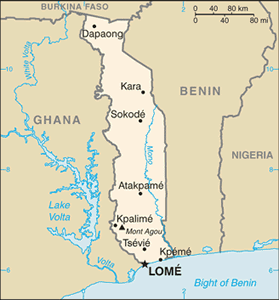The Geography of Togo
The Geography of Togo
Togolese Geography
Location: Western Africa, bordering the Bight of Benin, between Benin and Ghana
Geographic coordinates: 8 00 N, 1 10 E
Map references: Africa
Area: total: 56,785 sq km land: 54,385 sq km water: 2,400 sq km
Area - comparative: slightly smaller than West Virginia
Land boundaries: total: 1,647 km border countries: Benin 644 km, Burkina Faso 126 km, Ghana 877 km
Coastline: 56 km
Maritime claims: territorial sea: 30 nm exclusive economic zone: 200 nm
Climate: tropical; hot, humid in south; semiarid in north
Terrain: gently rolling savanna in north; central hills; southern plateau; low coastal plain with extensive lagoons and marshes
Elevation extremes: lowest point: Atlantic Ocean 0 m highest point: Mont Agou 986 m
Natural resources: phosphates, limestone, marble, arable land
Land use: arable land: 44.2% permanent crops: 2.11% other: 53.69% (2005)
Irrigated land: 70 sq km (2003)
Natural hazards: hot, dry harmattan wind can reduce visibility in north during winter; periodic droughts
Environment - current issues: deforestation attributable to slash-and-burn agriculture and the use of wood for fuel; water pollution presents health hazards and hinders the fishing industry; air pollution increasing in urban areas
Environment - international agreements: party to: Biodiversity, Climate Change, Climate Change-Kyoto Protocol, Desertification, Endangered Species, Law of the Sea, Ozone Layer Protection, Ship Pollution, Tropical Timber 83, Tropical Timber 94, Wetlands, Whaling signed, but not ratified: none of the selected agreements
Geography - note: the country's length allows it to stretch through six distinct geographic regions; climate varies from tropical to savanna


